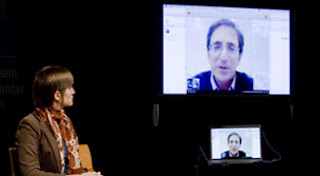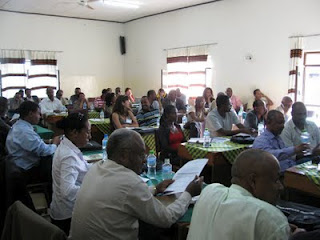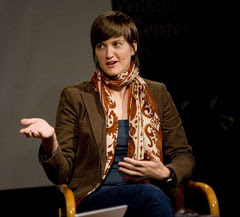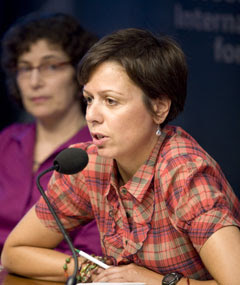-
Pakistan’s Demographic Challenge Is Not Just Economic
›In a meeting with business leaders in Lahore in late October, Secretary of State Hillary Rodham Clinton pointedly warned of the potential economic impacts of Pakistan’s rapidly growing population: “There has to be…in any plan for your own economic future, a hard look at where you’re going to get the resources to meet these needs. You do have somewhere between 170 and 180 million people. Your population is projected to be about 300 million as the current birth rates, which are among the highest in the world, continue,” she said.
Pakistan is ranked 141 (out of 182 countries) in the Human Development Index. High rates of unemployment are compounded by low levels of education and human capital. Clinton noted that Pakistani women are more vulnerable to poverty; only 40 percent are literate, compared to 68 percent of men.
The Secretary’s emphasis on the need to provide adequate education, jobs, and resources to motivate economic growth and improve well-being is welcome. But demography also has important political consequences. U.S. policymakers and the Pakistani government should consider the impact of population dynamics on the country’s intensifying instability.
As Pakistan’s population grows rapidly, it is maintaining a very young age structure: in 2005, two-thirds of its population was younger than age 30. Research by Population Action International has shown that countries with very young age structures are three times as likely to experience outbreaks of civil conflict than those with a more balanced age distribution.
The members of a “youth bulge” are not inherently dangerous, but when governments are unable to foster employment opportunities or the prospects of stability, a young age structure can serve to exacerbate the risks of conflict, as recently noted by John O. Brennan, assistant to the president for Homeland Security and Counterterrorism, in a speech on “A New Approach to Safeguarding Americans.”
As Secretary Clinton and her colleagues consider the complex barriers to achieving peace and stability for Pakistan’s people, their humanitarian and development strategies should include demographic issues. When couples are able to choose the number and timing of their children, very young age structures like Pakistan’s, can change.
Family planning and reproductive health services are fundamental human rights, but remain out of reach for many in Pakistan, where one-quarter of all married women (and 31 percent of the poorest) have an unmet need for family planning.
Greater access to family planning would lower fertility rates and increase the share of working-age adults in the population. In this transition, countries can harness the “demographic dividend”—a change that could turn Pakistan’s age structure into an economic opportunity.
However, funding from the United States—the world’s largest single donor for international family planning—has declined by one-third over the past 15 years. The foreign assistance funding priorities of the Obama administration should reflect this recognition of the linkages between population, development, and stability.
By addressing the high unmet need for family planning and reproductive health services of women in countries like Pakistan, the United States could help to create a more balanced age structure in future generations—and promote stability at the same time.
Elizabeth Leahy Madsen is a research associate at Population Action International (PAI). She is the primary author of the 2007 PAI report The Shape of Things to Come: Why Age Structure Matters to a Safer, More Equitable World.. -
Ethiopia: A Holistic Approach to Community Development Blossoms Two Years After Taking Root
›November 12, 2009 // By Sean Peoples As evening fell upon Yirgalem, Ethiopia, more than 70 participants from a large cross-section of Ethiopia’s NGO community—as well as a few international participants like myself—gathered in a packed conference room in the Furra Institute for the second annual General Assembly of the Consortium for the Integration of Population, Health, and Environment (CIPHE).
As evening fell upon Yirgalem, Ethiopia, more than 70 participants from a large cross-section of Ethiopia’s NGO community—as well as a few international participants like myself—gathered in a packed conference room in the Furra Institute for the second annual General Assembly of the Consortium for the Integration of Population, Health, and Environment (CIPHE). -
The Youth Bulge Question
›Right now, Rich Cincotta is live on “PRB Discuss Online,” answering the question, “Does a Young Age Structure Thwart Democratic Governments?” He is responding to reader questions like “Do Democratic governments being overcome by poverty and high unemployment rates have a chance to succeed” and “Why do you think the mainstream demography community is so slow or unwilling to pick up the research questions you have pursued?” Read the transcript and Cincotta’s recent article on this topic, “Half a Chance: Youth Bulges and Transitions to Liberal Democracy.”
A new World Bank working paper, “Breaking the Waves? Does Education Mediate the Relationship Between Youth Bulges and Political Violence?” by Bilal Barakat and Henrik Urdal finds “evidence that large, young male population bulges are more likely to increase the risk of conflict in societies where male secondary education is low”–particularly in low and middle-income countries. Mardy Shualy of Foreign Policy’s blog suggests policymakers do the math to compare the costs of secondary education to the economic toll of war and civil conflict. -
Covering Climate: What’s Population Got to Do With It?
›November 9, 2009 // By Dan Asin“There’s a correlation between CO2 and population. And it’s that we live in a world of more people, more money and more things, and that all distills down to the need for more energy,” said Dennis Dimick, executive editor of National Geographic, at a Wilson Center event on the media’s coverage of climate change and population, co-sponsored by the Society of Environmental Journalists and the International Reporting Project.
“Thinking about population and trends in population is a vital reality check for assessing policies you hear about on global warming,” said New York Times reporter Andrew Revkin, who joined Dimick and Nation Web Editor Emily Douglas via video conference. “When you start to think about that number—nine billion—a lot of cheery suppositions or assertions you’ve heard about how we’re going to de-carbonize the world without too much effort…[get] challenged in a hurry,” he said.
The Inconvenient Truth of Population
Despite these strong connections, the mainstream media has been reluctant to write about population growth, which Revkin called the “ultimate incremental story.”
“We, I think, are guilty to some extent, in the media, of not paying adequate attention to this part of the whole issue,” he said, partly because there is the perception that “we kind of solved that problem. But, again, just run those numbers: Nine billion people does not solve the climate problem and it has to be considered in every stage of assessing solutions to the climate problem.”
“We need to talk about it so we understand this issue at a level beyond more people means more emissions,” said Douglas. Other factors like levels of consumption, urbanization, and household structure make the population-emissions relationship complex and difficult to explain.
Revkin added that “consumption is even a tougher story to get at in print, because we’re a medium that advertises consumption, among other things.”
The Population-Energy Challenge
One-quarter of the world’s population lacks access to electricity. “We are in this sort of double-vise, trying to constrain our own [energy] demand while also trying to provide the opportunities for people who have little to none,” said Dimick.
of double-vise, trying to constrain our own [energy] demand while also trying to provide the opportunities for people who have little to none,” said Dimick.
With fossil fuels currently providing 80 percent of global energy, and with energy demand estimated to increase dramatically to meet the needs of 2.3 billion more people by 2050, the “scale of the challenge before us . . . is immense,” he said. “To think that we’re somehow simply going to go to solar and wind—I think we’re deluding ourselves.”
Nevertheless, Dimick insisted on the need “to de-carbonize at a tremendous scale.” He proposed sustainably addressing energy needs by improving energy efficiency, expanding mass transit systems, changing land use, and considering nuclear power.
Reproductive Health Is Key
Douglas, who previously edited the RH Reality Check blog, emphasized that population issues go far beyond climate change. “I’m encouraging us to look at population not only from the perspective of the environment, but also from the perspective of individual women and their human rights, their right to determine the number and spacing of their children, and not purely to depress fertility rates in service of mitigating climate change,” she said. According to Douglas, each year 60 million pregnancies—one-third of the global total—are unintended, and 200 million women worldwide have an unmet need for contraception. Family planning programs are “cheap to employ and deploy, and women and societies want them anyway,” said Douglas. A few recent studies have argued that universal access to family planning could be one of the most cost-effective ways to reduce greenhouse gas emissions.
According to Douglas, each year 60 million pregnancies—one-third of the global total—are unintended, and 200 million women worldwide have an unmet need for contraception. Family planning programs are “cheap to employ and deploy, and women and societies want them anyway,” said Douglas. A few recent studies have argued that universal access to family planning could be one of the most cost-effective ways to reduce greenhouse gas emissions.
And not just mitigation, but adaptation as well: “Women with access to reproductive health services are healthier and they’re better able to deal with the impacts of climate change,” she said. “Poorer countries are going to need adaptation strategies, and one of those strategies is to allow women to better determine the size of their families.”
However, “many political leaders–not only on the right—don’t like reproductive health programs,” said Douglas. Disagreements over abortion and birth control are part of the problem, as well as past instances of coercive contraceptive methods in some developing countries.
Douglas cited a Population Action International survey that “found that 41 countries identified population growth as a factor that makes them more vulnerable to climate change, but only two of those countries proposed programs that address reproductive health.”
Douglas decried the “significant gap between political leaders’ understanding that population growth makes it more difficult for them to respond to climate change, and political leaders being able to muster the political will that will empower women to better control their own fertility.”
Close-Up on the Most Vulnerable
“We also can’t talk about this as though all people added to the world population produce greenhouse gases in equal measure,” said Douglas. “The world’s richest half billion people, that’s 7 percent of the global population, are responsible for 50 percent of the world’s carbon dioxide emissions. Meanwhile, the poorest 50 percent are responsible for just 7 percent of emissions.”
Revkin urged reporters to use a “close-up lens” when examining population trends impact on climate—especially in “areas of the world where there are significant risks that could be amplified by human-driven climate change, like urban severe flooding and severe rains, like we saw in Manila recently.”
With rapid urbanization in the developing world, “you have to look at places where you have hugely increased numbers of people moving essentially into harm’s way—or being born in harm’s way, if you’re talking about sub-Saharan Africa,” said Revkin.
A Thought Experiment
“What if the whole world were equal in emissions?” Revkin asked. Suppose advanced industrial countries, such as the United States, reduce their annual emissions intensity from 20 tons of CO2 per person to 10 tons. At the same time, suppose rapidly developing countries, such as India, reach the same emissions intensity. In a world with nine billion people that equates to 90 billion tons—“three times today’s current annual emissions of CO2,” he said.
“Probably the single most concrete and substantive thing a young American could to do to lower a carbon footprint is not turning of the lights or driving a Prius, but having fewer children,” said Revkin. “Eventually, should you get credit—if we’re going to become carbon-centric—for having a one child family when you could’ve had two or three? Obviously it’s just a thought experiment, but it raises some interesting questions.”
Drafted by Daniel Asin and Meaghan Parker
Edited by Meaghan Parker -
Today: International Day for Preventing the Exploitation of the Environment in War and Armed Conflict
›November 6, 2009 // By Sajid Anwar“There can be no durable peace if the natural resources that sustain livelihoods are damaged or destroyed,” said UN Secretary-General Ban Ki-moon, in his message today, the 9th annual International Day for Preventing the Exploitation of the Environment in War and Armed Conflict. He called for “Member States to clarify and expand international law on environmental protection in times of war.”
Coinciding with this year’s observance, the United Nations Environment Programme, along with the Environmental Law Institute, released “Protecting the Environment During Armed Conflict: An Inventory and Analysis of International Law,” which finds serious gaps and weaknesses in international law and offers 12 recommendations for the UN and policymakers.
“Destroying and damaging the natural assets and ecological infrastructure of a country or community should be an issue of highest humanitarian concern,” said UNEP Executive Director Achim Steiner in a UNEP press release.
Earlier this year, Steiner spoke at the Wilson Center to launch From Conflict to Peacebuilding: The Role of Natural Resources and the Environment. In a recent ECSP video interview, UNEP’s David Jensen spoke about how post-conflict resource management can be a platform for economic recovery and cooperation. -
VIDEO: David Jensen on UNEP and Natural Resource Management After Conflict
›November 5, 2009 // By Sajid Anwar“We don’t do the gloom-and-doom scenarios anymore,” says David Jensen of the UN Environment Programme’s Post-Conflict and Disaster Management Branch, in a video interview with ECSP Director Geoff Dabelko. “We focus on the opportunities provided by resource management. We focus much more on how they can support economic recovery, how they support livelihoods, how environment can be a platform for cooperation.”
When conducting its post-conflict environmental assessments, UNEP looks for “entry points using specific hotspots or specific sites that people can really understand and see the linkage between environment and conflict, or between their livelihoods and natural resources,” says Jensen. “We always try to be in the field and demonstrate the value of better resource management” for post-conflict recovery. -
Climate-Security Gets “To the Point” Today
›Today’s episode of NPR’s “To the Point” with Warren Olney will focus on “Global Warming and the Geo-Political Map,” seeking to answer the question, “What are the risks to natural resources, immigration, and political stability worldwide?”
As one of the four panelists, ECSP Director Geoff Dabelko will draw on his recent article in the Bulletin of Atomic Scientists and ECSP’s climate-security resources.
Climate security has been heating up the media for the last few months, although most news coverage has been rather thin. That’s understandable, given the complexity of the drivers involved, and the crushing constraints on environmental reporters’ time and budgets these days. But climate security is a politically powerful argument, one which advocates from all over the political spectrum have increasingly adopting, and it deserves a more thorough, thoughtful treatment.
“Come to Attention,” a panel at this year’s SEJ annual conference (audio) moderated by ClimateWire’s Lisa Friedman, delved into some of the finer points of this often oversimplified connection. As part of the panel, Dabelko outlined seven cautions to keep in mind and suggestions for improving coverage of the difficult link.
While Grist’s Robert McClure jokingly called the session “doom and gloom without the sense of humor,” Dabelko ended on a positive note, pointing out that by coming together to battle climate change, countries may build bridges to peace, rather than war–particularly if the militaries cooperate in the fight.
In a recent op-ed, Dabelko and the U.S. Army War College’s Kent Butts argue that climate could be one of the most productive avenues for improving military relations with China, suggesting that “U.S. and Chinese militaries should jointly assess the security implications of climate change that concern both sides: rising sea levels, changing precipitation patterns, uncertain migration scenarios, and instability in resource-rich regions.”
“To the Point” airs live online at 3 PM EST. In the Washington, DC, area listen to it at 10 PM EST tonight on WAMU 88.5. -
Reporting From Kenya: U.S. Editors Cover Health, Environment, and Security
›November 4, 2009 // By Sajid Anwar The global recession has “been very hard on journalists,” explained Andrea Crossan, radio producer for BBC’s “The World”. “With these kinds of cutbacks, you really feel it when it comes to foreign coverage.” Along with Stephanie Hanson, associate director and coordinating editor of CFR.org, and Margaret McElligott, senior producer for washingtonpost.com, Crossan spoke about the International Reporting Project’s (IRP) Gatekeeper trip to Kenya at a Wilson Center event sponsored by the Environmental Change and Security Program.
The global recession has “been very hard on journalists,” explained Andrea Crossan, radio producer for BBC’s “The World”. “With these kinds of cutbacks, you really feel it when it comes to foreign coverage.” Along with Stephanie Hanson, associate director and coordinating editor of CFR.org, and Margaret McElligott, senior producer for washingtonpost.com, Crossan spoke about the International Reporting Project’s (IRP) Gatekeeper trip to Kenya at a Wilson Center event sponsored by the Environmental Change and Security Program.
“You’ve seen a lot of areas of the world that just aren’t getting the coverage these places deserve, and Africa is one of those places,” said Crossan, partly due to the expense of travel, security, and satellite equipment. IRP, a project of The Johns Hopkins University’s School of Advanced International Studies, aims to fill gaps in foreign reporting left by extensive budget cuts by offering U.S.-based editors and journalists opportunities to report on international stories.
“I’ve traveled a fair amount with the BBC, and I’ve seen some really difficult living conditions for people. I’ve never seen anything like I’ve seen in Kibera,” said Crossan. “We can look at all of the things we are talking about today”—environment, health, security—“through what’s happening in Kibera.”
Poverty and Pirates
At a meeting at the University of Nairobi, a student criticized foreign reporting of Kenya, saying that it “only seems to cover poverty and pirates,” said Crossan. That’s a slight improvement over previous years, when U.S. coverage focused on “witches and war,” noted an audience member.
McElligott, who previously worked for AllAfrica.com, agreed that U.S. media coverage of Africa is becoming richer, with fewer instances of racism accompanying reporting. “The world is so much smaller now,” with email, Facebook, blogs, and video providing additional venues and in-country contacts, she said.
The Kenyan press is the “most trusted institution” in the country, said Hanson. They expose corruption, report on health issues, and call the government to task. With the decline in U.S. journalists posted abroad, the support and stories provided by Kenyan reporters is crucial to getting coverage in the international media.
While pitching international stories to U.S. audiences might be a hard sell, “if it’s a good, compelling story, it will go up in a prominent place” with or without a U.S. angle, said McElligott. “It’s just about telling human stories,” said Crossan.
Kenya on the Edge: Drought and Conflict “In the last months we’ve seen the food crisis grow in Kenya,” said McElligott. On the group’s visit to Laikipia, she noted the impacts of soil degradation, unsustainable water extraction from rivers, and the lack of governmental regulation. Lack of land and water is forcing pastoralists to travel miles away from home in order to feed cattle and goats.
“In the last months we’ve seen the food crisis grow in Kenya,” said McElligott. On the group’s visit to Laikipia, she noted the impacts of soil degradation, unsustainable water extraction from rivers, and the lack of governmental regulation. Lack of land and water is forcing pastoralists to travel miles away from home in order to feed cattle and goats.
“We’re desperate for water here,” said Laikipia resident Niyok Npanyaki in an IRP video report. “We’ve decided that if water is cut off, we’ll go to the water source on Mount Kenya, even if the government doesn’t let us. Otherwise we will die. People don’t start wars for no reason. If I am hungry, but if you have food, I’ll come to you and find it.”
“Loss of natural resources puts people under extreme pressure and people will go to extreme lengths in order to get those fundamentally important natural resources,” says Dr. Anthony King, director of Laikipia Wildlife Forum, in the video. Adding to the tension between farmers and pastoralists is the easy access to firearms in the Horn of Africa. “Almost every pastoralist will have an automatic weapon,” says King.
The IRP fellows visited the headquarters of the UN Environment Programme in Nairobi, but found it difficult to gauge the effectiveness of UNEP at addressing Kenya’s drought and deforestation. According to Crossan, UNEP has invested in a number of local programs, but the UNEP officials they spoke with seemed frustrated that the Kenyan government was not more involved in tackling the country’s environmental problems.
“Something I struggle with in my own work is trying to understand what actual effect these large multilateral agencies have on the ground. What is the World Bank actually doing in Ghana? What are they actually doing in Kenya?” said Hanson. “Does the money get distributed? Who does it go to? Having more Kenyans or Ghanaians who could report on these things and look into them in terms of transparency and accountability would be incredibly helpful.”
Malaria: A Disease of the Poor “Malaria was, to be honest, not a disease that was really on my radar,” said Hanson. “I had, in a way, discounted its importance to what has happened on the continent.” At a children’s critical care unit in Nyanza Province, one of the poorest areas in Kenya with one of the highest rates of HIV and malaria, she saw beds filled with sick children. “This was shocking to me.”
“Malaria was, to be honest, not a disease that was really on my radar,” said Hanson. “I had, in a way, discounted its importance to what has happened on the continent.” At a children’s critical care unit in Nyanza Province, one of the poorest areas in Kenya with one of the highest rates of HIV and malaria, she saw beds filled with sick children. “This was shocking to me.”
When a family member is stricken with malaria, the burden of care is typically falls upon the mother, who often must travel long distances to the nearest hospital—“some of them had walked hours with a sick child,” said Hanson—leaving their other children at home and farms largely untended.
“When these women have to leave their farms to come to the clinic, they’re losing work days on the farm,” said Hanson. “That just means that their farms are less productive. They have less money to send their children to school, give their children medical care, and feed their children.”
“These macro-political issues—disputed elections, post-election violence—are actually connected to daily issues like malaria infections, hospital capacity rates, agricultural yields, and without a government that can address those things it is very difficult to see how a place like Kenya can move forward,” concluded Hanson.
Drafted by Sajid Anwar and Meaghan Parker.
Edited by Meaghan Parker.
 A Publication of the Stimson Center.
A Publication of the Stimson Center.

 As evening fell upon Yirgalem, Ethiopia, more than 70 participants from a large cross-section of Ethiopia’s NGO community—as well as a few international participants like myself—gathered in a packed conference room in the
As evening fell upon Yirgalem, Ethiopia, more than 70 participants from a large cross-section of Ethiopia’s NGO community—as well as a few international participants like myself—gathered in a packed conference room in the  of double-vise, trying to constrain our own [energy] demand while also trying to provide the opportunities for people who have little to none,” said Dimick.
of double-vise, trying to constrain our own [energy] demand while also trying to provide the opportunities for people who have little to none,” said Dimick. According to Douglas, each year 60 million pregnancies—one-third of the global total—are unintended, and
According to Douglas, each year 60 million pregnancies—one-third of the global total—are unintended, and  The global recession has “been very hard on journalists,” explained
The global recession has “been very hard on journalists,” explained  “In the last months we’ve seen the food crisis grow in Kenya,” said McElligott. On the group’s visit to Laikipia, she noted the impacts of soil degradation, unsustainable water extraction from rivers, and the lack of governmental regulation. Lack of land and water is forcing pastoralists to travel miles away from home in order to feed cattle and goats.
“In the last months we’ve seen the food crisis grow in Kenya,” said McElligott. On the group’s visit to Laikipia, she noted the impacts of soil degradation, unsustainable water extraction from rivers, and the lack of governmental regulation. Lack of land and water is forcing pastoralists to travel miles away from home in order to feed cattle and goats. “Malaria was, to be honest, not a disease that was really on my radar,” said Hanson. “I had, in a way, discounted its importance to what has happened on the continent.” At a
“Malaria was, to be honest, not a disease that was really on my radar,” said Hanson. “I had, in a way, discounted its importance to what has happened on the continent.” At a 

